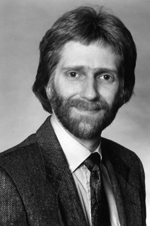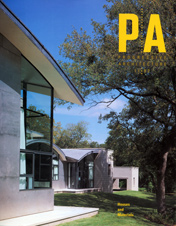| Kenneth Labs 1950-1992 | |
 |
 |
| Ken Labs (1992) | Progressive Architecture, Nov. 1992 |
Kenneth Labs, who as a senior editor of Progressive Architecture (P/A) remade the magazine’s Technics department, died on September 19 of mesothelian cancer in a Branford, Connecticut, hospice. Ken came to P/A in 1989 with a broad range of experience. After getting his Master of Architecture degree from Washington University in St. Louis, he worked in private architectural practice in Connecticut and Texas, in town planning in Pennsylvania, and in research. As a visiting lecturer, he taught environmental technology at the Yale School of Architecture, and he wrote a number of published documents on planning, underground construction, and energy-efficient design, including the 1983 book Climatic Design: Energy-Efficient Building Principles and Practices, which he coauthored with Donald Watson. So by the time he arrived at P/A in 1989 for what would turn out to be—by his own accounting—his longest stretch in one job, Ken had some clear ideas about what an architecture magazine’s technical coverage should be. Unlike previous Technics editors, he did relatively little writing himself, preferring to edit papers by experts in various fields. He began commissioning articles from researchers, practitioners, and consultants, giving them a venue for publishing new research. Such a strategy was new to P/A; in the past, we had most often applied a kind of journalistic filter to Technics coverage. Ken’s method earned us new attention and respect both from readers and from the research community. The method also brought controversy, since the authors of our Technics articles tended to advance particular points of view. An article on brick veneer and steel studs (Feb. 1992, p. 113), for example, spawned five responses from other experts, which Ken published—along with the author’s response to each (June 1992, p. 47). Ken often said that, in order to be taken seriously, the architecture profession needed a refereed journal like those of the medical profession, where papers are submitted to peer review before publication. Establishing such a journal was one of his long-term goals; in the meantime, he did his best to push our Technics department in that direction. But his influence on P/A extended beyond Technics. He was a vocal participant in our weekly editorial meetings, often playing devil’s advocate on design issues. He had a scientist’s impatience with the way some architects package vague ideas as “theory,” insisting that a theory is a set of prescriptions, not an ethereal set of influences. From his frequent calls for more empirical criticism to his dogged defense of the suburb, Ken challenged our opinions and kept us on our toes. But Ken’s criticism was easy to take, because of his genial, country-bred manner. He was born on March 21, 1950, in Doylestown, Pennsylvania, and grew up in nearby Mechanicsville, where his parents, George and Violet Labs, had a chicken farm. In some ways, Mechanicsville never left him: he kept the do-it-yourself mentality that one learns on a farm. At work, that meant devising his own detailed style manual for Technics writers and sketching his own layouts before meeting with the art department. At home, it meant lavishing attention on his 1950s builder ranch in Mt. Carmel, Connecticut, putting in new halogen lighting, an elaborate sound system, and storage units with scrupulously matched moldings. He kept us updated on these projects, along with the running battle he waged with chipmunks over his strawberries. Another of his passions was for music; he liked to say he had a guitar for every day of the week, and he sometimes played jazz guitar in New Haven nightspots. At least once, this interest cropped up in P/A: he illustrated an article on acoustics (April 1991, p. 45) with a Robert Johnson album cover that depicted the blues guitarist singing and playing while facing the corner of a hotel room. Ken, remembering the cover, had his assistant rooting through second-hand record stores to track it down for his story. Not all of us were aware of his other interests until his death; among them were nature photography, bird watching, and writing poetry. We learned from one editor that he was crazy about rhubarb and had collected dozens of rhubarb recipes for a possible book. It sounded like Ken; he approached every pursuit as a scholar, categorizing and cataloguing and learning all he could. As Ken’s cancer advanced, he became less able to make the commute from his home to our office in Stamford. Armed with a fax machine and a modem, though, he continued his work eagerly, giving it up only when his physical symptoms prohibited it. In his later faxes, his zeal for questioning the magazine’s status quo only increased; “You can say anything you want when you have cancer,” he explained. Less than a month before his death, Ken was married to Joanne Improta, formerly P/A’s Circulation Marketing Manager. We were all heartened to know that Ken was spending his last days with Joanne, whom we knew to be warm, caring, and—clearly—courageous. Besides his wife and parents, Ken is survived by a brother and sister-in-law, Wayne and Nancy Labs, of Doylestown, and their son, Jonathan. To all of them we extend our warmest sympathies. Ken was an irreplaceable colleague, and a good friend. |
|